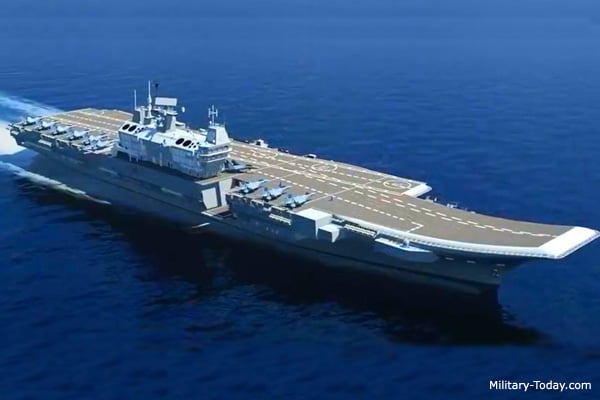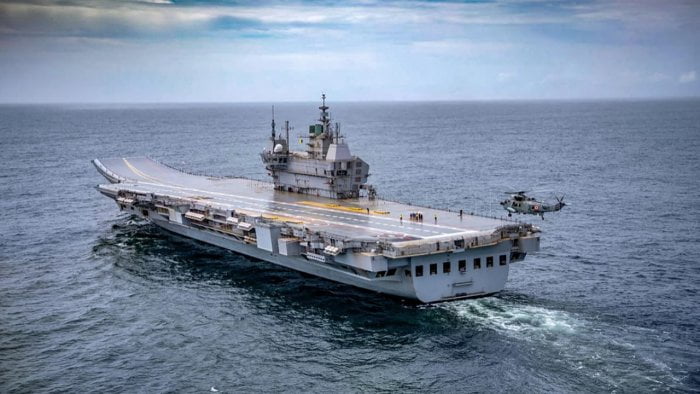The first made-in-India aircraft carrier, INS Vikrant, was inaugurated on Friday by Prime Minister Narendra Modi, who called it a “historic moment” and an “outstanding emblem of self-reliance India.” The Prime Minister commissioned the carrier, which cost 23,000 crores, at a ceremony held at the Cochin Shipyard Limited in Kochi, Kerala.
The NS Vikrant was created with cutting-edge automated technologies and is the largest ship ever built in India’s nautical history. It has a substantial amount of indigenous equipment and machinery, with participation from big industrial enterprises as well as over 100 MSMEs. The carrier has a displacement of around 45,000 tonnes, making it the largest warship in the Indian Navy’s inventory.
‘Vikrant’ was named after its historic predecessor, India’s first aircraft carrier, which played a critical part in the 1971 war. The Indian Navy’s in-house Warship Design Bureau (WDB) designed it, and Cochin Shipyard Limited, a Public Sector Shipyard under the Ministry of Ports, Shipping, and Waterways built it.

INS Vikrant 2022 Details
The indigenous aircraft carrier INS Vikrant measures 262 meters (860 feet) long and 62 meters (203 feet) wide, with a displacement of around 45,000 metric tonnes (44,000 long tons). It has a STOBAR design and a ski jump. The deck is intended to allow aircraft like the MiG-29K to operate from the carrier. It is expected to transport up to thirty aircraft, including up to 24-26 fixed-wing combat aircraft, principally the MiG-29K, as well as ten Kamov Ka-31 or Westland Sea King helicopters. The Ka-31 will provide functionality airborne early warning (AEW), while the Sea King will provide anti-submarine warfare (ASW).
Vikrant is powered by four General Electric LM2500+ gas turbines on two shafts, producing more than 80 megawatts (110,000 hp). The gearbox of carriers are designed and supplied by Elecon Engineering.
Tata Power Strategic Engineering Division collaborated with Weapon and Electronics System Engineering Establishment and MARS, Russia to design the ship’s combat management system (CMS). It is the first CMS created for the Indian Navy by a commercial enterprise, and it was delivered to the Navy on March 28, 2019.
INS Vkrant 2022 Motto
The newly commissioned INS Vikrant also carries on its predecessor’s Rigvedic motto, “Jayema Sam Yudhi Sprudhah,” which means “I conquer those who fight against me.”
INS Vikrant 2022 :History
Vikrant is the first aircraft carrier designed by the Indian Navy’s Directorate of Naval Design and the first warship built by Cochin Shipyard. A large number of private and public firms were involved in its construction.
The Defence Metallurgical Research Laboratory (DMRL) and the Steel Authority of India Limited (SAIL) established facilities in India to manufacture DMR 249 grade steel. According to reports, the Bokaro Steel Plant in Jharkhand, Bhilai Steel Plant in Chhattisgarh, and Rourkela Steel Plant in Odisha produced 26,000 tonnes of three types of special steel for the hull, flight deck, and floor compartments. As a result, Vikrant is the Indian Navy’s first ship to be constructed entirely of domestically produced steel.
The main switchboard, steering gear, and watertight hatches were made in Mumbai and Talegaon by Larsen & Toubro; the high-capacity air conditioning and refrigeration systems were made in Kirloskar Group’s plants in Pune; the majority of the pumps were provided by Best and Crompton; the Integrated Platform Management System (IPMS), which was provided by Bharat Heavy Electricals (BHEL), was installed by the Italian firm Avio; and the gearbox was provided by Eleco. While Nevskoye Design Bureau in Russia designed the aviation complex, Fincantieri offered consulting services for the propulsion package.
INS Vikrant 2022:Specifications
Vikrant’s characteristics are as follows:
- Length: 262.5 m
- 61.6 m in width
- Height (from the keel to the pole mast): 61.6 m
- Displacement: approximately 42.800 tonnes
- Maximum/cruise speed: 28/18 knots
- Area of the Flight Deck: 12.500 SqM
- Propulsion: 22MWx4 GTs, 3MWx8 DAs
- 7500 nautical miles of range
- Armaments: SAM-32xMRSAM, AK630 CIWS
- Air Wing: 30 aircraft and helicopters
- Runway: 191m for landing, 203m for long take-off, and 145m for short take-off.
- 6 helicopter landing zones
- 3 x Wires for Arresting Gear
- Two (1014 m) SAC lifts
INS Vikrant 2022: Length
The INS Vikrant has a length of 262 meters, a width of 62 meters, and a height of 59 meters. It has a 7,500 nautical mile endurance range, 2,300 compartments, a crew of 1700 people, a separate hospital complex, and unique cabins for ladies.
The aircraft carrier is excessively long, as it can accommodate 26 MiG-29K fighter jets, four Kamov Ka-31 helicopters, two HAL Dhruv NUH utility helicopters, and four MH-60R multi-role helicopters.
INS Vikrant 2022: Cost
The Directorate of Naval Design of the Indian Navy created the INS Vikrant, which was constructed at the CSL public sector shipyard for a cost of Rs 20,000 crore (Cochin Shipyard Limited). At the time of the project’s initial sea testing, the project’s entire cost was roughly Rs. 23,000 crores ($2.9 billion).
INS Vikrant 2022 : Launch Date
The design of the INS Vikrant began in 1999, and the keel was laid in February 2009. The carrier floated out of its dry dock on December 29, 2011, and was launched on August 12, 2013. After the ship’s sea trials began in August 2021, the basin trials were completed in December 2020. Prime Minister Narendra Modi officially commissioned INS Vikrant into the Indian Navy on September 2, 2022. Flight tests for the aircraft should be completed by the middle of 2023.
INS Vikrant 2022: Commissioning Status
On September 2, 2022, at a formal ceremony held at the Cochin Shipyard, Prime Minister Narendra Modi officially launched INS Vikrant. Earlier, on July 28, 2022, INS Vikrant was handed over to the Indian Navy. By the middle of 2023, the ship’s fleet of aircraft should have finished its flight tests, at which point it will be fully operational.
Vikrant will be berthed in Chennai’s Kattupalli Port.
By the time the naval facility at Rambilli is anticipated to be open, the Navy plans to lease a 260 m berth at Kattupalli shipyard for 8 years between 2022 and 2030 for interim berthing of the ship.
PM Modi, who is on a two-day tour of Kerala and Karnataka, tweeted on Thursday that “Tomorrow, 2nd September, is a landmark day for India’s efforts to become Atmanirbhar (self-reliant) in the military sector.” “INS Vikrant, the nation’s first aircraft carrier, will be put into service. Additionally, the new Naval Ensign (Nishaan) will be introduced.
5 hidden facts about INS VIKRANT:
1. The Indian Navy claims that the carrier INS Vikrant, which is 262 metres long, has a full displacement of close to 45,000 tonnes and is both larger and more sophisticated than its predecessor.
2. Vikrant is the largest ship ever built in India’s maritime history; it is as vast as two football fields, according to a video from the Indian Navy.
3. The hangar that will house the aircraft is large enough to house two Olympic swimming pools, according to the Navy.
4. Floating city with 18 stories: Known as a floating city with 18 stories, the INS Vikrant has 14 decks and 2,300 compartments. It can accommodate about 1,500 sea warriors, and its cook, known as the ship’s galley, produces about 10,000 chapatis or rotis daily to meet food needs.
5. Mix of 30 aircraft: When discussing the IAC Vikrant’s specifications, Vice Admiral Hampiholi stated that the INS Vikrant carries a variety of up to 30 aircraft, including MIG-29K fighter jets, Kamov-31, MH-60R multi-role helicopters, as well as locally produced Advanced Light Helicopters (ALH) and Light Combat Aircraft (LCA) (Navy).
How INS Vikrant significantly boosted the Indian economy:
According to a news release, the nation’s economy benefited from the indigenization activities since they supported the expansion of ancillary businesses and created jobs for 13,000 ancillary industry workers and 2,000 CSL employees. According to earlier statements from the Navy, more than 50 Indian companies were actively participating in the project, and IAC-1 directly employed close to 2,000 Indians every day. Over 40,000 additional indirect jobs were created.
The Navy estimates that 80% to 85% of the project’s projected $23,000 billion cost was spent in India.
Conclusion
With the construction of INS Vikrant, India has joined a select group of nations, including the US, UK, Russia, China, and France, that are capable of designing and building their own aircraft carriers.
The Indian Navy views the new vessel as a vital equipment upgrade. Now that India has an aircraft carrier stationed on both its eastern and western borders, it is able to expand its maritime influence. India’s modern navy consists of one aircraft carrier, ten destroyers, twelve frigates, and twenty corvettes.

